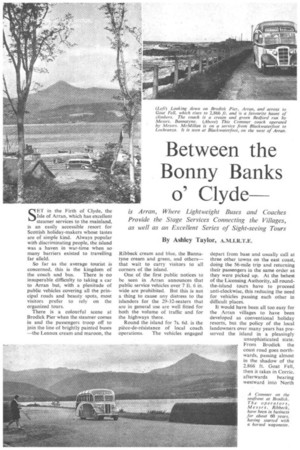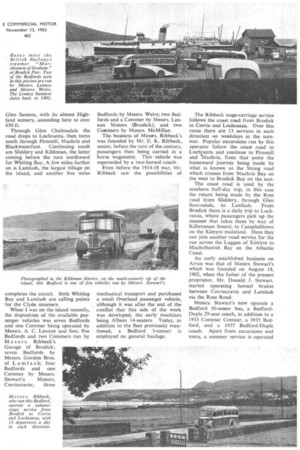Between the
Page 114

Page 115

Page 116

If you've noticed an error in this article please click here to report it so we can fix it.
Bonny Banks o' Clyde
is Arran, Where Lightweight Buses and Coaches Provide the Stage Services Connecting the Villages, as well as an Excellent Series of Sight-seeing Tours
By Ashley Taylor, A.M.I.R.T.E. SET in the Firth of Clyde, the Isle of Arran, which has excellent steamer services to the mainland, is an easily accessible resort for Scottish holiday-makers whose tastes are of simple kind. Always popular with discriminating people, the island was a haven in war-time when so • many barriers existed to travelling far afield.
So far as the average tourist is concerned, this is the kingdom of the coach and bus. There is no insuperable difficulty to taking a car to Arran but, with a plenitude of public vehicles covering all the principal roads and beauty spots, most visitors prefer to rely on the organized tours.
There is a colourful scene at Brodick Pier when the steamer comes in and the passengers troop off to join the line of brightly painted buses —the Lennox cream and maroon, the Ribbeck cream and blue, the Bannatyne cream and green, and others— that wait to carry visitors to all corners of the island.
One of the first public notices to be seen in Arran announces that public service vehicles over 7 ft. 6 in. wide are prohibited. But this is not a thing to cause any distress to the islanders for the 29-32-seaters that are in general use are well fitted for both the volume of traffic and for the highways there.
Round the island for 7s. 6d. is the piece-de-resistance of local coach operations. The vehicles engaged depart from base and usually call at three other towns on the east coast, doing the 56-mile trip and returning their passengers in the same order as they were picked up. At the behest of the Licensing Authority, all roundthe-island tours have to proceed anti-clockwise, this reducing the need for vehicles passing each other in difficult places.
It would have been all too easy for the Arran villages to have been developed as conventional holiday resorts, but the policy of the local landowners over many years has preserved the island in a pleasingly unsophisticated state. From Brodiek the coast road goes northwards, passing almost in the shadow of the 2,866 ft. Goat Fell, then it takes in Corrie, afterwards bearing westward into North Glen Sannox, with its almost Highland scenery, ascending here to over 650 ft.
Through Glen Chalmadale the road drops to Lochranza, then turns south through Pirnmill, Machrie and Blackwaterfoot. Continuing south are Sliddery and Kildonan, the latter coming before the turn northward for Whiting Bay. A few miles farther on is Lamlash, the largest village on the island, and another five miles completes the circuit. Both Whiting Bay and Lamlash are calling points for the Clyde steamers.
When I was on the island recently, the disposition of the available pas senger vehicles was seven Bedfords and one Commer being operated by Messrs. A. C. Lennox and Son; five Bedfords and two Commers run by Messrs. Ribbeck's Garage of Brodick; seven Bedfords by Messrs. Gordon Bros. of Lamlash; four Bedfords and one Commer by Messrs.
Stewart's Motors, Corriecravie; three Bedfords by Messrs. Weirs; two Bedfords and a Commer by Messrs. Lennox Motors (Brodick); and two Commers by Messrs. McMillan.
The business of Messrs. Ribbeck's was founded by Mr. E. K. Ribbeck, senior, before the turn of the century, passengers then being carried in a horse wagonette. This vehicle was superseded by a two-horsed coach.
Even before the 1914-18 war, Mr. Ribbeck saw the possibilities of mechanical transport and purchased a small Overland passenger vehicle, although it was after the end of the conflict that this side of the work was developed, the early machines being Albion 14-seaters. Today, in addition to the fleet previously mentioned, a Bedford 3-tonner is employed on general haulage. The Ribbeck stage-carriage service follows the coast rood from Brodick to Corrie and Lochranza. Over this route there are 13 services in each direction on weekdays in the summer. Popular excursions run by this operator follow the coast road to Lochranza and continue to Pirnmill and `Machrie, from that point the homeward journey being made by what is known as the String road which crosses from Machrie Bay on the west to 13rodick Bay on the east.
The coast road is used by the southern half-day trip, in this case the return being made by the Ross road from Sliddery, through Glen Scorradale, to Lamlash. From Brodick there is a daily trip to Lochranza, where passengers pick up the steamer that takes them by way of Kilbrennan Sound, to Campbelltown on the Kintyre mainland. Here they can join another road service for the run across the Laggan of Kintyre to Machrihanish Bay on the Atlantic Coast.
An early established business on Arran was that of Messrs. Stewart's which was founded on August 18, 1902, when the father of the present proprietor, Mr. Donald J. Stewart, started operating horsed brakes between Corriecravie and Lamlash via the Ross Road.
Messrs. Stewart's now operate a Bedford 30-seater bus, a BedfordDuple 29-seat coach, in addition to a 1933 Commer Centaur, a 1935 Bedford, and a 1937 Bedford-Duple coach. Apart from excursions and tours, a summer service is operated between Blackwaterfoot, on the west coast, and Lamlash, and a winter service is run between Corriecravie and Lamlash. A stage-carriage service from Lower Kildonan to Whiting Bay is operated throughout the year. Haulage work is performed with a Bedford 5-tonner under A licence, and sub-depots are established at Whiting Bay and Kildonan.
All the vehicles owned by Messrs. Stewart's Motors are maintained by their own staff who carry out all operations, including bodywork repairs and painting. Mr. Stewart, senior, founder of the business and father of the present proprietor, will be recalled by many visitors; he is now 83 years of age.
Back in about 1903, Mr. Alex C. Lennox gave up farming in Lanarkshire and came to reside at Whiting Bay where he started contracting with a horse and cart, gradually extending his business to the hiring of pony and trap, horses and wagonettes and, finally, to a coach and pair.
The Last Word
Towards the end of the 1914-18 war, the need for buses was seen and Mr. Lennox ordered an Albion 14-seater which was delivered late in 1919 and cost about £1,850. Despite having a most unwieldy canvas hood and 'being fitted with solid rubber tyres all round, this vehicle was considered the last word in luxury at that time and transported hundreds of holidaymakers on tours round Arran.
Mr. A. C. Lennox, the son, recollects digging this vehicle out of the peat bogs on which some sections of Arran roads are built but cannot recall a single mechanical breakdown. Various hire cars were added to the fleet and in 1923 the family set about building the original Pier Garage at Whiting Bay. Mr. A. C. Lennox, junior, and Mr. Donald Lennox entered into partnership with their father in 1924 and have traded under the title of A. C. Lennox and Sons since that date.
Rapid Success
In 1925, they purchased a Fiat 14-seater in place of the Albion and in 1928 two Chevrolet 14-seaters were added to the fleet; at this time a stage-carriage service being opened up between Whiting Bay and Brodick. This venture met with early success and two Chevrolet 18-seaters were added in 1929, to be followed by a series of new 13edfords.
Other stage-carriage facilities provided include a seasonal service (summer only) between Whiting Bay and King's Cross and a local run operated in connection with church services on Sundays only since about 1930.
During the past war, co-ordination of timetables was arranged with Messrs. Gordon Bros. on the Whiting Bay-Brodick service and, certain advantages having been derived from this arrangement, the joint timetable has been arranged and interchangeable return tickets issued. The present fleet consists of seven Bedford and one Commer passenger vehicles and a dozen hire cars.
For a long period one goods vehicle was operated, but in 1946 the business operated by Mr. William Currie was taken over and a limited company, called Wm. Currie (Transport), Ltd., formed. This has been developed so that today four Bedford 5-ton lorries and a Ford 10-cwt. van are operated. For five years Mr.
Currie retained an interest in the business but in 1951 he sold out, the entire shareholding now being owned by the Lennox brothers.
In 1951 they purchased the Pier Garage, Brodick, which is operated under the title of Lennox Motors (Brodick) under the management of Mr. A. Robertson. A special feature of the tours run by this organization is the Central Arran trip which crosses the island from Brodick via the String road and returns from Sliddery via the Ross road, giving a close-up view of Arran moorland and peaks. Round Arran and north circular runs are also operated.
Petrol is still delivered to Arran garages in drums and Mr. A. C. Lennox stressed the care needed in costing operationswith the commercial grade selling at 4s. 'lid. per gallon and top grades at 4s. 10i-d. and 4s. Hid. in that area. The business of Messrs. Gordon Bros. (1. K. and E. Gordon), of Lamlash, was started in 1922 when a car hire service was offered. Success in this sphere was followed six years.
later by a decision to open out into a wider field and Chevrolet buses were purchased with which both stage-carriage services and excursions were operated.
Of the seven 13edfords now owned, three have coach bodies and four are buses. Scheduled services are worked between Brodick, Whiting Bay, and Lamlash—the points, of call for the Clyde steamers—as well as tours to all parts of Arran.
Messrs. Weirs run from Pirnmill and Machrie to Brodick throughout the year in connection with the Clyde steamers, and Messrs. MeMillans operate Blackwaterfoot to Lochranza during the summer season only. Messrs. Bannatynes work an all-the-year-round service from Brodick to Blackwaterfoot and Shedog.
Although visitors to Arran usually come to stay for a while, a certain amount of traffic comes to local operators by means of special through-bookings that are now available via rail and steamer from the mainland.
All the firms' operations are, of course, curtailed during the winter months when visitors are few. Stagecarriage services are also much reduced on Sundays in both summer and winter. There is a limited amount of private-hire work in connection with local social events during the winter months, but generally the seasonal nature of the traffic enables the operators' staffs to concentrate most of their energy on overhauls and maintenance at that time.
For the purpose of secondary education, children from all over the island are brought in to Lamlash to school and special buses from the various villages in the island set out, sometimes as early as 8 a.m., every school day. As the brisk holiday traffic is confined to a period between the beginning of June and the end of September, the provision of school buses provides a valuable source of revenue to a number of operators from the beginning of October until April












































































































































































































































